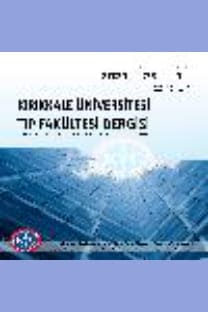Akut Apandisitte Preoperatif Tetkikler-Laparotomi Korelasyonu
Akut apandisit, preoperatif değerlendirme, patolojik inceleme
Pages 1-4
___
- Memişoğlu K, Karip B, Mestan M, Onur E. The value of preoperative diagnostic tests in acute appendicitis, retrospective analysis of 196 patients. World J Emerg Surg. 2010; 5(5): 12
- Ma KW. If not appendicitis, then what else can it be? A retrospective review of 1492 appendectomies. Hong Kong Med J. 2010; 16(1): 12Simpson J, Samaraweera APR, Sara RK, Lobo DN. Acute appendicitis–a benign disease?. Annals of The Royal College of Surgeons of England. 2008; 90(4): 313.
- Khairy G. Acute appendicitis: Is removal of a normal appendix still existing and can we reduce its rate? Saudi journal of gastroenterology: official journal of the Saudi Gastroenterology Association. 2009; 15(3): 167. de Castro SMM, Ünlü Ç, Steller EP, van Wagensveld BA, Vrouenraets BC. Evaluation of the appendicitis inflammatory response score for patients with acute appendicitis. World journal of surgery. 2012; 36(7): 1540-5.
- Ashdown HF, D’Souza N, Karim D, Stevens RJ, Huang A, Harnden A. Christmas Research: Pain over speed bumps in diagnosis of acute appendicitis: diagnostic accuracy study. BMJ: British Medical Journal. 2012; 3doi: 1136/bmj.e8012
- Menteş Ö, Eryılmaz M, Coşkun K, Harlak A, Özer T, Kozak O, Bedair ES. The Importance of Heel Drop Physical Examination Sign in Diagnosis of Acute Appendicitis. Eur J Surg Sci. 2010; 1(3): 7782
- Goulart RN, Silverio GS, Moreira MB, Franzon O. Main findings in laboratory tests diagnosis of acute appendicitis : a prospective evaluation. ABCD Arq Bras Cir Did. 2012; 25(2): 88-90
- Gaitini, D. (2011). Imaging acute appendicitis: state of the art. Journal of clinical imaging science, 1.doi: 4103/2156-7514.85778
- Reich B, Zalut T, Weiner SG. An international evaluation of ultrasound vs. computed tomography in the diagnosis of appendicitis. International journal of emergency medicine. 2011; 4(1): 1-7.
- Zhu B, Zhang B, Li M, Xi S, Yu D, Ding Y. An evaluation of a superfast MRI sequence in the diagnosis of suspected acute appendicitis. Quantitative imaging in medicine and surgery. 2012; 2(4): 280.
- Hussain A, Mahmood H, Singhal T, Balakrishnan S, El-Hasani S. What is positive appendicitis? A new answer to an old question. Clinical, macroscopical and microscopical findings in 200 consecutive appendectomies. Singapore Med. J. 2009; 50: 1145-9.
- Turhan AN, Kapan S, Kutukcu E, Yigitbas H, Hatipoglu S, Aygun E. Comparison of operative and non operative management of acute appendicitis. Ulus Travma Acil Cerrahi Derg. 2009; 15(5): 459-62.
- Son CS, Jang BK, Seo ST, Kim MS, Kim YN. A hybrid decision support model to discover informative knowledge in diagnosing acute appendicitis. BMC Medical Informatics and Decision Making. 2012; 12(1): 17. Yazışma Adresi: Dr. Aybala Ağaç Ay
- Kırıkkale Üniversitesi Tıp Fakültesi Hastanesi, Genel Cerrahi A.D./ Kırıkkale Telefon: 05052301555
- ISSN: 2148-9645
- Yayın Aralığı: Yılda 3 Sayı
- Başlangıç: 1999
- Yayıncı: KIRIKKALE ÜNİVERSİTESİ KÜTÜPHANE VE DOKÜMANTASYON BAŞKANLIĞI
Tonsillektomi Sonrası Geç Kanama - Olgu Sunumu
Bengi ARSLAN MUTLU, , Hatice GÜZELKÜÇÜK, Rahmi KILIÇ
İnguinal Herni-Prostatizm Birlikteliklerine Güncel Yaklaşım
Aybala Ağaç Ay, , Volkan Kınaş, Işın Gençay, Abdullah Çetin
Fetal Morbiditeyi Öngörmede Umblikal Arter Kan pH’i ve Birinci Dakika APGAR Skorunun Değerleri
Plasenta Previa ve Uzamış Membran Rüptürü Olan Olguda İhmal Edilmiş Mentum Posterior Yüz Geliş
, Rukiye Ada BENDER, Aykan YÜCEL, Volkan NOYAN, Gülsüm Yıldız SERBEST, Nevin SAĞSÖZ, Çağatay BÖLGEN
Akut Apandisitte Preoperatif Tetkikler-Laparotomi Korelasyonu
Aybala AĞAÇ AY, , Volkan KINAŞ, İşın GENÇAY, Abdullah ÇETİN
, Murat Tulmaç, Hatice Özdemir, Ömer Şahin, Fatih POYRAZ, Vedat ŞİMŞEK, Derya CANLI, Haksun EBİNÇ
Uzun Mezorşiuma Bağlı Testis Torsiyonu: Olgu Sunumu
, Süleyman AYVAZ, Salih KARACA, Hakan GENÇHELLAÇ, Mehmet KİRİCİ, Ekrem ÇANCİLAR, Mehmet PUL
İnhalasyon Yaralanmalarının Tanı ve Tedavisi: Literatürün Gözden Geçirilmesi
